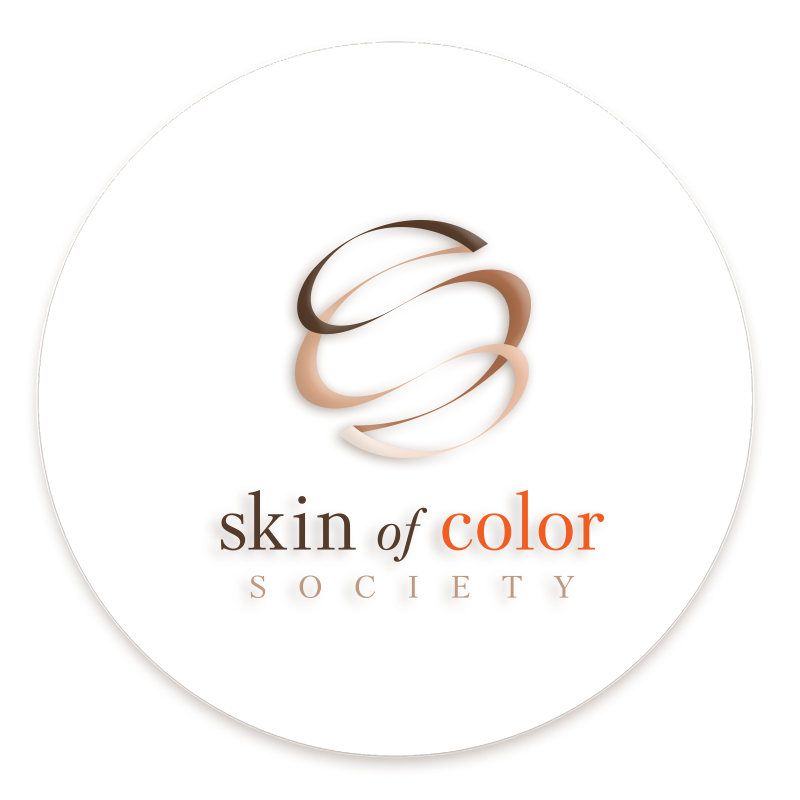Cosmetics and Skin Rejuvenation
Chere Lucas, MD
Cosmetic products and procedures are becoming increasingly popular and readily available. These services and products are designed to reduce signs of aging and sun damage, and improve the appearance of scars. With so many options available, it can be confusing to determine which treatments will work best for you. Most cosmetic services are safe and effective in skin of color. However, there are several things to consider when choosing cosmetic services. The most common products and procedures will be discussed below as well as possible side effects.
Skin of color patients may present with specific concerns that are more relevant to this sub-population due to unique biological features which affect aging. Specifically, patients of Asian descent are often concerned about hyperpigmented (brown) spots on the face that may develop over time. patients of African descent often present with concerns of deepening of facial lines, facial discoloration, and development of dermatosis papulosa nigra, a common condition in individuals with darkly pigmented skin. It consists of multiple tiny, non- cancerous, skin-colored or hyperpigmented (brown) papules on the face, neck, and cheeks. The lesions increase in number with age. Latino/a patients often are concerned about under eye circles, skin discoloration, and wrinkles.
Cosmetic Products and Prescription Medications:
Skin care products that can improve signs of aging contain ingredients such as retinol, glycolic acid, antioxidants, peptides, growth factors and DNA repair enzymes. Some are available over the counter and others may be available through your dermatologist. Health experts advise everyone, regardless of skin color, to use a sunscreen with a SPF of at least 30 every day. Although dark-skinned people won’t get sunburned as quickly, they will still burn and are still susceptible to sun-induced skin damage, such as brown spots, wrinkles and cancer.
Available as creams or gels, prescription medications such as topical retinoids (tretinoin, adapalene and tazarotene) can help to reduce signs of aging by exfoliating, lightening brown spots and reducing fine lines and wrinkles. They can also help to reverse sun damage. Hydroquinone (bleaching cream) can be used alone or in combination with retinoids to lighten brown spots. A compounding pharmacy may be utilized to customize a prescription formulation tailor made to a particular patient’s skin care needs. Your dermatologist can suggest the right skin care routine for your skin.
Microdermabrasion:
Microdermabrasion uses small crystals to exfoliate (gently remove) the very top layers of skin. This helps to unclog pores and promote new skin cell growth. There is minimal down time after the procedure.
Chemical peels:
Chemical peels are used to resurface the skin to help with facial rejuvenation, treatment of acne, and skin discoloration. A chemical solution is gently applied to the skin, which over time removes the top layer of skin causing it to peel off. There are many different types of chemical peels. Superficial chemical peels are similar to microdermabrasion and remove only the very top layer of the skin. These are the most commonly used type of peel in patints with skin of color.Not all chemical peels should be used in skin of color. Deeper peels (anything more than superficial) can cause dark (hyperpigmented) or light (hypopigmented) patches and can even lead to scarring. It is therefore important to be evaluated by a dermatologist ahead of time, and have a dermatologist perform your chemical peels.
Lasers:
Lasers are available for hair removal, tattoo removal, treatment of birthmarks, redness, brown spots, pores, and acne. Laser uses light at a specific wavelength to treat the skin. There are many different types of lasers depending on what is being treated. People with skin of color are more likely than light-skinned individuals to get side effects with certain lasers such as lightening or darkening of the skin, burning and even scarring. Not all lasers can be used on darker skin types, so it may be necessary to test the area to be treated on a small part of the skin first. It is important to make sure that the provider treating you has experience with skin of color and the use of lasers. Lasers can be a very safe and effective treatment for skin of color patients, if performed in the right hands.
Intense Pulsed Light (IPL):
Intense pulsed light is also known as a “photofacial” or “photorejuvenation”. It can be used to lighten brown spots, improve redness and improve fine lines. It uses high intensity visible light to treat the skin and is similar to laser. There is risk of scarring and permanent pigmentary changes if the IPL is used in tanned skin or darker skin types. It is important to see a dermatologist to see if this procedure is a good fit for you.
Botulinum Toxin:
Botulinum toxin A is used to improve fine lines and wrinkles of the forehead, between the brows and around the eyes (crow’s feet). It also can be used in other locations, such as the lower face, neck, and armpits for bothersome sweating. When someone squints or frowns, the skin forms lines. Over time, the lines can become permanently wrinkled. Botulinum can be injected into the muscles that cause these wrinkles. This causes the muscles to relax and can soften or erase these lines.
Fillers:
Fillers are substances that are put into the skin to restore volume loss to create a more youthful appearance, plump lips and fill in lines. Fillers smooth the appearance of wrinkles. Most commonly, fillers are made of hyaluronic acid, which is a soft gel. Hyaluronic acid is a normal substance in the skin and is not permanent. For temporary fillers, the effects will typically resolve in about 6-9 months depending on the type of product used. Some longer lasting fillers, such as Sculptra or Radiesse, are also available and your dermatologist can discuss these with you and see if they are a good fit for your needs.
Microneedling with or without Radiofrequency:
Microneedling is procedure where tiny needles are used to induce new collagen, elastin, and brightness to the skin. If heat is applied to the tips of those needles, skin tightening and wrinkle relaxation can also occur. This treatment can be used on the face, body, or specific areas for scarring. It is important that your provider is familiar with this procedure in skin of color patients, as they are at increased risk of skin discoloration after the procedure.
Your doctor can decide which of the above treatments are best for your skin. In many cases, more than one treatment can be used to enhance the skin and create a more youthful appearance.
Additional Resources
National Library of Medicine NIH MedLine: Dermabrasion, Botox






